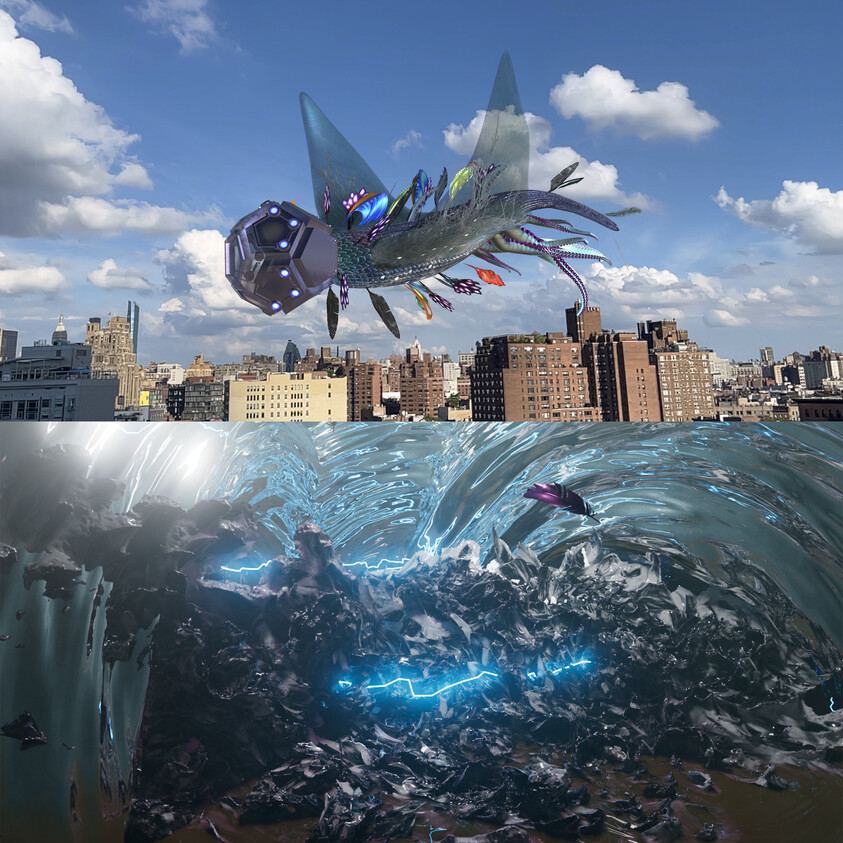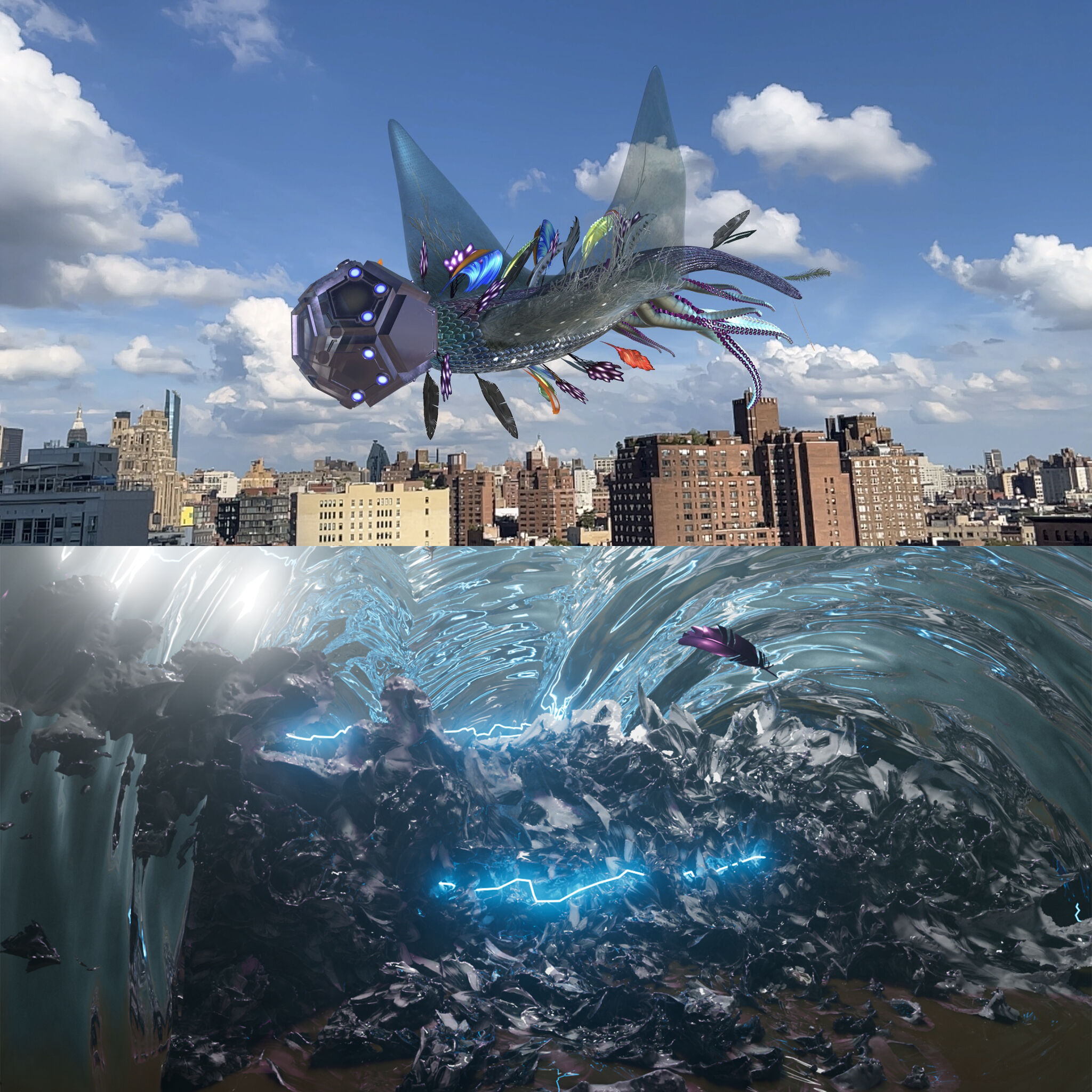Verbal Description: Nancy Baker Cahill, CENTO, 2023
Sept 27, 2023
0:00
Verbal Description: Nancy Baker Cahill, CENTO, 2023
0:00
Download 4th Wall to choose AR feathers with different properties and add them to CENTO’s body on IOS and Android.
Narrator: Nancy Baker Cahill’s CENTO is a monumental, augmented reality creature flying over the Museum and viewable from the terraces. It is a fictional, futuristic entity transformed through viewers’ participation: if you download the free 4th Wall app and select “CENTO,” you can select one of twelve different feathers, place it on the creature’s body and view CENTO flying over the Museum. The project is accompanied by a video—accessible online at artport.whitney.org and on the 6th floor terrace—that takes viewers on a tour through CENTO’s imagined habitat and also allows you to download the app from QR codes.
The creature CENTO does not have defined measurements because it’s AR, but appears in space to be around 17 feet long.
Cahill created this futuristic entity by combining different species into one interconnected body. It moves in graceful curves, like a giant winged whale swimming slowly overhead. CENTO’s core has pale glowing stripes running lengthwise along its purple body, with a geometric head and wings that are dark yet transparent so the colors of the sky are subtly apparent through the animal. Its body is lined with dark purple metallic scales and pale filaments—these are mycelium, the fibers that grow from fungi. The large, slowly flapping wings are those of a manta ray, and colorful feathers and tentacles float down off the edges of CENTO’s body, like streamers on a kite. The feathers that participants can place on the body have different functionalities, including communication, navigation, energy conversion, and memory bank.
The creature’s head–which is a hexagonal shape adorned with evenly-spaced circular lights–spins in its socket. The app emits a soundtrack that is almost prehistoric and futuristic sounding, with screeching metal elements over a windy whooshing sound.
The artist conceived of this work as responding to climate change and an increasingly uninhabitable planet. Together, the aspects of this work imagine a fictional entity whose diverse functionality would ensure its evolutionary survival.
CENTO takes its name from the term for a “collage poem” consisting of lines from other poets’ works, alluding both to the collage body of the creature and the audience’s contributions to the work. The accompanying video of CENTO’s habitat can be found on the sixth floor terrace on a monitor measuring 28 inches tall by 55 inches wide. The video itself reveals the creature’s cave-like habitat, and drifts through three distinct settings: the nest, the refueling chamber, and the space where the creature metabolizes its fuel into energy and takes flight. The view opens onto a slowly-zooming-in fictional landscape swirling with silvery water ripples towards its upper and outer edges that halo around a seemingly rough center terrain, CENTO’s nest. The terrain is a deep pewter with shiny brown edges, and across its expanse there are blue electric current lines flickering horizontally. As we zoom in, the occasional feather floats across our view, suggesting it has been shed from CENTO’s body. The soundtrack is at once ominous, mysterious, and futuristic, with bubbling sounds and voltage buzzes against an extended instrumental hum.
As we zoom in further, the electric buzz intensifies, heightening the drama of this watery scene. The camera pauses, turns to another corner of the rocky nest, and continues to zoom. Another musical element grows as the camera zeroes in on one opening in the rockface, and the screen goes dark momentarily. Then, the music altered to a hollow glitchy din, we are in the refueling chamber with colorful seaweed-like plants swaying upwards out of a silty floor. The vertical plant leaves are magenta and teal, and have both shine and transparency. These effects heighten our awareness of this world’s highly digital rendering, each of the elements sleek, their movements choreographed. There are small bubbles floating upward, and in the background silvery water ripples suggesting the water’s surface arch in a rainbow shape over the seaweed. The camera continues forward and we seem to go deeper into yet another chamber. A different landscape emerges from darkness, which is the metabolizing area where CENTO rests pre-flight: spikey spherical pod-like forms float on an expanse of slick metallic liquid. The scene is dark purple and blue. The liquid undulates up and down as if we the viewer are far at sea, now on top of the waves. The camera then tips upward towards a digital sky expanse and fades to pale purple. Futuristic sans-serif font text appears, which reads:
You toured the habitat of CENTO, a hybrid, bioengineered future creature in augmented reality (AR) that soars over the Whitney Museum. CENTO’s evolutionary survival depends on collective engagement: you can select one of twelve feathers to add to its body. Each feather is endowed with respective properties that will ensure its ability to thrive.
As this paragraph pauses on the screen, the tinny, looming music continues. Then the screen changes to one that has differently colored digital feathers displayed evenly throughout the screen. The words CENTO FEATHERS appear in the same font as the previous text, this time in dark brown outlined letters. The screen ripples and moves slightly, as if under a thin layer of water. The next screen presents the viewer with two QR codes to access the accompanying app that will let you add feathers to the AR creature. The left QR code is for iOS systems, the right for Android. These QR codes are also available on the wall text to the left of the video monitor.


